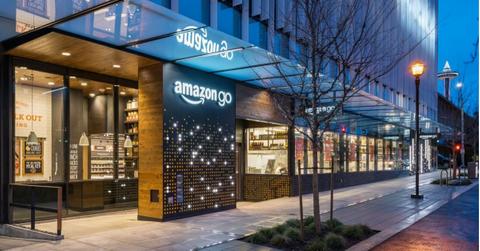Amazon Announces New Investments In Solar Power
The tech company will install 20 megawatts of solar panels at U.K. fulfillment centers, and invest in U.S. recycling efforts.
Updated Oct. 23 2018, 2:29 p.m. ET
Amazon is making a push towards sustainability with new commitments to renewable energy and recycling. Last week, the company announced plans to install 20 megawatts worth of solar panels at fulfillment centers in the U.K. and invest $10 million in the Closed Loop Fund, which aims to improve recycling infrastructure in the United States.
The U.K. solar installations will take place over the next 18 months. Amazon is targeting 10 fulfillment center rooftops, and claims this network will generate enough electricity to power the equivalent of 4,500 homes. The new panels will also, Amazon says, reduce its carbon footprint by 6,500 metric tons of carbon dioxide per year.
These solar installations represent a piece of a wider company goal. Amazon is aiming to install solar systems on 50 fulfillment centers by 2020, and this U.K. bundle will get it one-fifth of the way towards that target.
"As our fulfillment network continues to expand, we want to help generate more renewable energy at both existing and new facilities around the world in partnership with community and business leaders," said Stefano Perego, operations director for Amazon UK, said in a press release.
"We are putting our scale and inventive culture to work on sustainability, which is good for the environment, our business, our customers, and the communities in which we operate. By diversifying our energy portfolio, we can keep business costs low and pass along further savings to customers."
Amazon’s renewable energy investment will extend beyond the 10 solar-powered fulfillment centers. The company also announced an agreement to power its U.K. buildings with 100 percent renewable energy, which will be executed through Renewable Energy Guarantee of Origin certificates (REGOs).
The press release further highlights new battery systems, which will be installed at "a number" of U.K. fulfillment centers. These batteries are meant to improve Amazon’s energy demand management and frequency control. Centers that have the batteries will be able to charge the batteries overnight and then use them during peak power usage hours, helping the national grid run smoothly.
Meanwhile, the Closed Loop Fund investment will tackle waste reduction across the pond. According to another press release, the $10 million contribution will "increase the availability of curbside recycling" for three million American homes, and ultimately divert one million tons of recyclable material from landfills. This shift will, Amazon claims, eliminate the equivalent of two million metric tons of carbon dioxide by 2028.
"This investment will help build the local capabilities needed to make it easier for our customers and their communities to recycle and to increase the amount of material recycled across the country," Dave Clark, senior vice president of worldwide operations, said in the press release.
"We are investing in Closed Loop Fund’s work because we think everyone should have access to easy, convenient curbside recycling. The more we are all able to recycle, the more we can reduce our collective energy, carbon, and water footprint."
As The Verge reports, Amazon has traditionally lagged behind tech companies of its size — namely, Google, Apple, Facebook, and Microsoft — in sustainability initiatives. While it has eliminated more than 244,000 tons of packaging material through its Frustration-Free Packaging program, Amazon has not prioritized carbon neutrality as highly as its peers.
Apple, Google, and Microsoft already run on 100 percent renewable energy, with Facebook close behind. (The social media brand has set a 2020 target.) But Amazon has merely made a “long-term commitment” to 100 percent renewable energy on its cloud computing division — and it’s only halfway there.
Still, the new solar and recycling missions are encouraging steps in the right direction. With similar and sustained commitments, Amazon may finally catch up to its competitors' steep carbon cuts.
